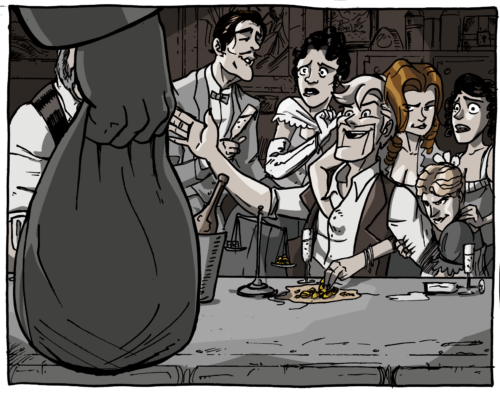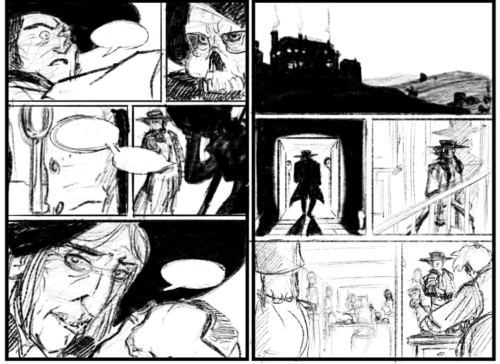The Tithe
Scripting comics really taught me the art of diction and how it can be used in artistic expression.
When I took a graduate short fiction workshop class, the professor said something that made my eyes roll at the time. He argued that short stories had more in common with poetry than novels and that, in a short story, every word matters because every word had a thematic and emotional impact. You needed to really consider rhythm and how the words in a sentence played off of each other to make sure it was all balanced and affective. I scoffed at the idea; “I just want to tell stories,” I told myself instead. To some extent I still hold that ideal, but I guess there’s a reason I’m not a prose fiction writer.
His meaning, however, came into sharp focus once I started making comics. Comics are born from a practice of brevity: of space, of art, of text. It is their mingling coexistence that demands only the essentials. Dialogue, especially, needs to be curt since it is arguably the easiest part of a comic to take up space if not managed well. And yet, in a read through, dialogue may be the only thing a reader pays attention to.
I learned quickly that the dialogue needs to serve a lot of different patrons. It serves the scene because information and interaction needs to be related to the reader. It serves the panel because placement of the dialogue balloon effects the composition of the art. The most impactful aspect dialogue serves on a page rests in the page turn.
As a rhetorical concept, the page turn is as old as comics, and a crucial one if designing for print. The basic idea is that when planning out pages, your even-numbered pages will be on the left and your odd-numbered pages will be on the right. In order to encourage the reader to turn the page, you need something to facilitate that want. You could end on a cliffhanger. You could leave off with unfinished dialogue to be continued on the next page. You could have a scene change at the bottom of the page that continues on the next. There are a lot of ways to maximize the page turn, in other words.

Behind the scenes: the blonde and redhead are absolutely taking advantage of the moment to distract Rich Jack and take as much of that gold as possible without him noticing. Click for larger version.
For me, I like to use page turns as punctuation. This, perhaps, is a vestige of my initial foray into comics as a webcomicker where every update/page needed to feel like a complete entry into the story––a beginning, middle, and end––where you end on a punchline (if a comedy comic) or the end of a scene. Having moved into the print realm, that idea transformed for me into making the page turn into a kind of thematic capstone of the page’s intent.
Dialogue, in that sense, works for me almost like a one-liner, but they aren’t jokes. Instead, dialogue––especially on a page turn––acts more like a thesis for the page or the scene. This is what it’s about, this is the message, this is the argument. That’s definitely the case with Hellrider Jackie’s final line on the previous page, that’s also the case with the final line on this page. It’s also the case in most pages going back and going forward. But they evolved into much more than a hook, they are messages reduced over heat into clear, focused statements, becoming title cards shuffled into scenes in silent movies.
Because I put that level of importance on these focused bits of dialogue, as well as the dialogue leading up to it, diction becomes incredibly important. It’s mostly a lesson in cutting and revising, whittling the dialogue down to the message, filtered only through the voice of the character. It’s a song and you want to make sure the chorus is an anthemic earworm.

The thumbnails for this page and the previous page. As you can see, a lot of revision happened in the final two panels of this page. Click for larger image.



Discussion ¬